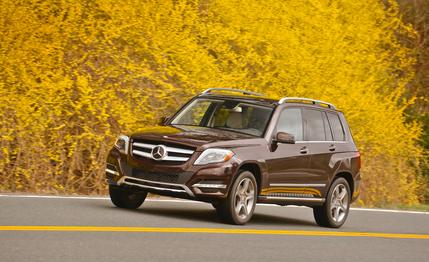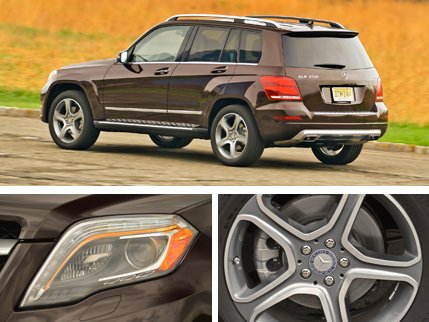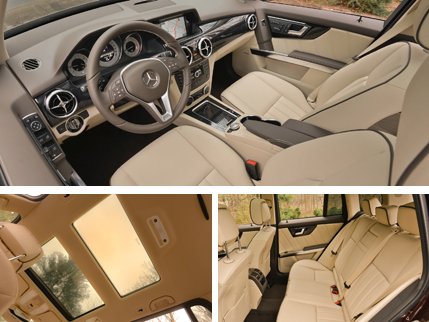 Instrumented Test
Instrumented Test
The GLK250 BlueTec is a diesel-drinking Hermès clutch of a crossover that hit stores this spring as a fashionably late member of the refreshed 2013 GLK lineup. Engine geeks ought to be thrilled by its tech-stuffed 2.1-liter, Benz’s first four-hole diesel in the U.S. since the naturally aspirated one in the 1985 190D. Back then, life was more leisurely with just 72 horsepower and 96 pound-feet underfoot—the GLK250 gives 200 horsepower at 3800 rpm and 369 pound-feet at 1600 rpm. A seven-speed automatic routes the output to a standard four-wheel-drive system.
Two turbochargers work in series. The smaller unit minimizes lag at low engine speeds, then a larger turbo takes over at higher speeds. Two balance shafts quell tremors, and four piezo injectors squirt fuel into the cylinders at 29,000 psi—nearly enough pressure to slice granite. The diesel’s exhalations are scrubbed clean by a urea-injection system drawing fluid from a 7.3-gallon tank located under the ute’s cargo floor.
The turbo-diesel delivers EPA ratings of 24 mpg in the city and 33 mpg on the highway, five and nine better, respectively, than the gas V-6 in the GLK350 4MATIC. Over nearly 800 miles of mixed driving, we saw 27 mpg, six better than a four-wheel-drive ’13 GLK350 we tested last fall.

The diesel GLK steps away from a stop on a swell of torque, more smartly than its 8.1-second zero-to-60-mph time might indicate. Power delivery is as smooth as a pair of patent-leather Louboutins, and the only lag is a two-beat pause when matting the accelerator at launch. Drive normally and the turbos do their jobs nearly imperceptibly. One caveat: Typical of diesels, top-end power isn’t commensurate with low-end torque, so you’ll want to plan out higher-speed passes.
Inside the cabin, the pattering of the pistons is pretty well muffled. The chassis wasn’t tweaked much beyond adding more driver-assistance programs, so the GLK behaves the same as before and offers great forward sightlines, obedient steering, controlled body motions, and a planted feel.

Want proof that whining works? Owners of the pre-refresh GLK squealed that its interior felt like an Asian knockoff, so the innards now feature better materials, revised instrumentation, spherical air vents, upgraded infotainment tech, and enough wood trim to build a life raft. The shifter also moved to the steering column, morphing into Benz’s corporate electronic gear-selector nub. That bequeaths console real estate to a storage bin with a tambour cover. The cabin now looks worthy of a vehicle that can be optioned up to $60K. (Most GLK buyers spend in the mid-$40,000s.)
Benz’s stylists also lightly retouched the exterior; the new front end resembles an aloof, cybertronic catfish. It also has LED running lights because everything else does now.
Diesels usually command a premium, but Mercedes has priced the GLK250 $500 lower than the GLK350 4MATIC, giving it a leg up in a suddenly burgeoning subset of compact luxury crossovers. The Audi Q5 TDI is on sale now, but costs $2100 more than a comparable gas V-6 Q5. And a yet-to-be-priced diesel BMW X3 arrives early next year, likely with a $1500 upcharge. Mazda may offer a diesel version of its fine-driving CX-5, too, but cross-shopping is unlikely; aficionados of posh purses know the label is everything. If you’re willing to drop bucks on a badge, you could do far worse than this GLK.